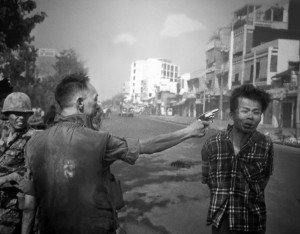As appearing in the Rocky Mountain Collegian
From Vietnam to Afghanistan, three Colorado State University journalists spent an evening at the Lory Student Center discussing their experiences covering combat zones.
The moderated discussion panel, titled “Photographing the Truth,” was hosted by the CSU Office of International Programs.
The panel included CSU professors Pete Seel and Larry Steward, veteran U.S. Air Force and U.S. Army photographers in Vietnam, respectively. Lt. Col. T.G. Taylor, a CSU alumnus and former chief of media relations at U.S. Central Command, joined the discussion remotely as well.
War coverage and access for journalists has changed since the Vietnam War, during which journalists covering combat had few restrictions to various locations and subjects. Journalists could disappear to search for stories, as long as they did not return empty handed, said Pete Seel, whose mission in the Vietnam War was to document what the Air Force was doing across Southeast Asia.
“We could get on the airfield in Saigon and get on any plane and go anywhere, anytime,” Seel said. “We had remarkable autonomy as photographers, where we could go and cover any story.”
During that time, journalists often sat next to the pilot or in the back seat of the plane. As the second person in the plane, they had to know how to operate the radio and navigation, said Seel.

During the Vietnam War, reporters were in the field on their own, Taylor said.
“They could go wherever they wanted, and sometimes they would get military assistance and sometimes they wouldn’t,” Taylor said.
Although not having military protection may have resulted in higher mortality rates among journalists in the field, Steward said the photographs they produced were influential.
“(Photographs have a) powerful impact on public policy and public opinion in this country and worldwide,” said Steward, who worked as a ground and aerial photographer in Vietnam.
Media coverage of the war affected public opinion, Seel said. As a result of the Vietnam War coverage, subsequent missions in Grenada and Panama gave journalists restricted access to combat zones.
Steward displayed a famous photo by Eddie Adams in which a South Vietnamese general executed a suspected Viet Cong fighter. Steward said Eddie Adams later regretted taking the photo because it became so iconic and shaped how the public viewed the war based off of just that one moment.
Taylor, who is a 20-year veteran of the U.S. Army and a 2008 graduate with a master’s degree in journalism, commented on how embedded journalists covering the war approached their work.
“I really wanted to take a look at what journalists were experiencing when they went to go cover conflict,” Taylor said. He found that despite having elaborate stories about close relationships with members of the military, journalists said they remained unbiased.
Many journalists in Taylor’s study suggested a team approach was needed to covering conflicts such as war. Some of the suggestions were that reporters cover the war from multiple locations to get different perspectives. According to Taylor, those who experienced this type of team reporting said their coverage was full and complete.
“Coverage isn’t positive or negative,” Taylor said. “It’s either truthful or it’s not truthful.”
Collegian Reporter Eleonora Yurkevich can be reached at news@collegian.com.
